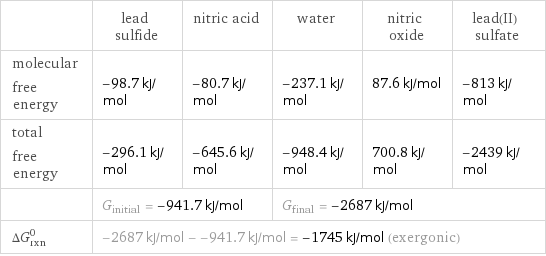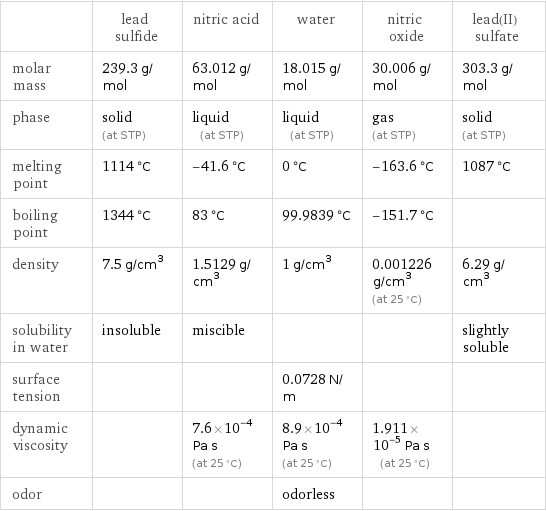Input interpretation

PbS lead sulfide + HNO_3 nitric acid ⟶ H_2O water + NO nitric oxide + PbSO_4 lead(II) sulfate
Balanced equation

Balance the chemical equation algebraically: PbS + HNO_3 ⟶ H_2O + NO + PbSO_4 Add stoichiometric coefficients, c_i, to the reactants and products: c_1 PbS + c_2 HNO_3 ⟶ c_3 H_2O + c_4 NO + c_5 PbSO_4 Set the number of atoms in the reactants equal to the number of atoms in the products for Pb, S, H, N and O: Pb: | c_1 = c_5 S: | c_1 = c_5 H: | c_2 = 2 c_3 N: | c_2 = c_4 O: | 3 c_2 = c_3 + c_4 + 4 c_5 Since the coefficients are relative quantities and underdetermined, choose a coefficient to set arbitrarily. To keep the coefficients small, the arbitrary value is ordinarily one. For instance, set c_1 = 1 and solve the system of equations for the remaining coefficients: c_1 = 1 c_2 = 8/3 c_3 = 4/3 c_4 = 8/3 c_5 = 1 Multiply by the least common denominator, 3, to eliminate fractional coefficients: c_1 = 3 c_2 = 8 c_3 = 4 c_4 = 8 c_5 = 3 Substitute the coefficients into the chemical reaction to obtain the balanced equation: Answer: | | 3 PbS + 8 HNO_3 ⟶ 4 H_2O + 8 NO + 3 PbSO_4
Structures

+ ⟶ + +
Names

lead sulfide + nitric acid ⟶ water + nitric oxide + lead(II) sulfate
Reaction thermodynamics
Gibbs free energy

| lead sulfide | nitric acid | water | nitric oxide | lead(II) sulfate molecular free energy | -98.7 kJ/mol | -80.7 kJ/mol | -237.1 kJ/mol | 87.6 kJ/mol | -813 kJ/mol total free energy | -296.1 kJ/mol | -645.6 kJ/mol | -948.4 kJ/mol | 700.8 kJ/mol | -2439 kJ/mol | G_initial = -941.7 kJ/mol | | G_final = -2687 kJ/mol | | ΔG_rxn^0 | -2687 kJ/mol - -941.7 kJ/mol = -1745 kJ/mol (exergonic) | | | |
Entropy

| lead sulfide | nitric acid | water | nitric oxide | lead(II) sulfate molecular entropy | 91 J/(mol K) | 156 J/(mol K) | 69.91 J/(mol K) | 211 J/(mol K) | 149 J/(mol K) total entropy | 273 J/(mol K) | 1248 J/(mol K) | 279.6 J/(mol K) | 1688 J/(mol K) | 447 J/(mol K) | S_initial = 1521 J/(mol K) | | S_final = 2415 J/(mol K) | | ΔS_rxn^0 | 2415 J/(mol K) - 1521 J/(mol K) = 893.6 J/(mol K) (endoentropic) | | | |
Equilibrium constant
![Construct the equilibrium constant, K, expression for: PbS + HNO_3 ⟶ H_2O + NO + PbSO_4 Plan: • Balance the chemical equation. • Determine the stoichiometric numbers. • Assemble the activity expression for each chemical species. • Use the activity expressions to build the equilibrium constant expression. Write the balanced chemical equation: 3 PbS + 8 HNO_3 ⟶ 4 H_2O + 8 NO + 3 PbSO_4 Assign stoichiometric numbers, ν_i, using the stoichiometric coefficients, c_i, from the balanced chemical equation in the following manner: ν_i = -c_i for reactants and ν_i = c_i for products: chemical species | c_i | ν_i PbS | 3 | -3 HNO_3 | 8 | -8 H_2O | 4 | 4 NO | 8 | 8 PbSO_4 | 3 | 3 Assemble the activity expressions accounting for the state of matter and ν_i: chemical species | c_i | ν_i | activity expression PbS | 3 | -3 | ([PbS])^(-3) HNO_3 | 8 | -8 | ([HNO3])^(-8) H_2O | 4 | 4 | ([H2O])^4 NO | 8 | 8 | ([NO])^8 PbSO_4 | 3 | 3 | ([PbSO4])^3 The equilibrium constant symbol in the concentration basis is: K_c Mulitply the activity expressions to arrive at the K_c expression: Answer: | | K_c = ([PbS])^(-3) ([HNO3])^(-8) ([H2O])^4 ([NO])^8 ([PbSO4])^3 = (([H2O])^4 ([NO])^8 ([PbSO4])^3)/(([PbS])^3 ([HNO3])^8)](../image_source/4a62cc35d4544e964d55bf662fac61ec.png)
Construct the equilibrium constant, K, expression for: PbS + HNO_3 ⟶ H_2O + NO + PbSO_4 Plan: • Balance the chemical equation. • Determine the stoichiometric numbers. • Assemble the activity expression for each chemical species. • Use the activity expressions to build the equilibrium constant expression. Write the balanced chemical equation: 3 PbS + 8 HNO_3 ⟶ 4 H_2O + 8 NO + 3 PbSO_4 Assign stoichiometric numbers, ν_i, using the stoichiometric coefficients, c_i, from the balanced chemical equation in the following manner: ν_i = -c_i for reactants and ν_i = c_i for products: chemical species | c_i | ν_i PbS | 3 | -3 HNO_3 | 8 | -8 H_2O | 4 | 4 NO | 8 | 8 PbSO_4 | 3 | 3 Assemble the activity expressions accounting for the state of matter and ν_i: chemical species | c_i | ν_i | activity expression PbS | 3 | -3 | ([PbS])^(-3) HNO_3 | 8 | -8 | ([HNO3])^(-8) H_2O | 4 | 4 | ([H2O])^4 NO | 8 | 8 | ([NO])^8 PbSO_4 | 3 | 3 | ([PbSO4])^3 The equilibrium constant symbol in the concentration basis is: K_c Mulitply the activity expressions to arrive at the K_c expression: Answer: | | K_c = ([PbS])^(-3) ([HNO3])^(-8) ([H2O])^4 ([NO])^8 ([PbSO4])^3 = (([H2O])^4 ([NO])^8 ([PbSO4])^3)/(([PbS])^3 ([HNO3])^8)
Rate of reaction
![Construct the rate of reaction expression for: PbS + HNO_3 ⟶ H_2O + NO + PbSO_4 Plan: • Balance the chemical equation. • Determine the stoichiometric numbers. • Assemble the rate term for each chemical species. • Write the rate of reaction expression. Write the balanced chemical equation: 3 PbS + 8 HNO_3 ⟶ 4 H_2O + 8 NO + 3 PbSO_4 Assign stoichiometric numbers, ν_i, using the stoichiometric coefficients, c_i, from the balanced chemical equation in the following manner: ν_i = -c_i for reactants and ν_i = c_i for products: chemical species | c_i | ν_i PbS | 3 | -3 HNO_3 | 8 | -8 H_2O | 4 | 4 NO | 8 | 8 PbSO_4 | 3 | 3 The rate term for each chemical species, B_i, is 1/ν_i(Δ[B_i])/(Δt) where [B_i] is the amount concentration and t is time: chemical species | c_i | ν_i | rate term PbS | 3 | -3 | -1/3 (Δ[PbS])/(Δt) HNO_3 | 8 | -8 | -1/8 (Δ[HNO3])/(Δt) H_2O | 4 | 4 | 1/4 (Δ[H2O])/(Δt) NO | 8 | 8 | 1/8 (Δ[NO])/(Δt) PbSO_4 | 3 | 3 | 1/3 (Δ[PbSO4])/(Δt) (for infinitesimal rate of change, replace Δ with d) Set the rate terms equal to each other to arrive at the rate expression: Answer: | | rate = -1/3 (Δ[PbS])/(Δt) = -1/8 (Δ[HNO3])/(Δt) = 1/4 (Δ[H2O])/(Δt) = 1/8 (Δ[NO])/(Δt) = 1/3 (Δ[PbSO4])/(Δt) (assuming constant volume and no accumulation of intermediates or side products)](../image_source/32ee2ab0ef8fc56c920dc5af659bfbf3.png)
Construct the rate of reaction expression for: PbS + HNO_3 ⟶ H_2O + NO + PbSO_4 Plan: • Balance the chemical equation. • Determine the stoichiometric numbers. • Assemble the rate term for each chemical species. • Write the rate of reaction expression. Write the balanced chemical equation: 3 PbS + 8 HNO_3 ⟶ 4 H_2O + 8 NO + 3 PbSO_4 Assign stoichiometric numbers, ν_i, using the stoichiometric coefficients, c_i, from the balanced chemical equation in the following manner: ν_i = -c_i for reactants and ν_i = c_i for products: chemical species | c_i | ν_i PbS | 3 | -3 HNO_3 | 8 | -8 H_2O | 4 | 4 NO | 8 | 8 PbSO_4 | 3 | 3 The rate term for each chemical species, B_i, is 1/ν_i(Δ[B_i])/(Δt) where [B_i] is the amount concentration and t is time: chemical species | c_i | ν_i | rate term PbS | 3 | -3 | -1/3 (Δ[PbS])/(Δt) HNO_3 | 8 | -8 | -1/8 (Δ[HNO3])/(Δt) H_2O | 4 | 4 | 1/4 (Δ[H2O])/(Δt) NO | 8 | 8 | 1/8 (Δ[NO])/(Δt) PbSO_4 | 3 | 3 | 1/3 (Δ[PbSO4])/(Δt) (for infinitesimal rate of change, replace Δ with d) Set the rate terms equal to each other to arrive at the rate expression: Answer: | | rate = -1/3 (Δ[PbS])/(Δt) = -1/8 (Δ[HNO3])/(Δt) = 1/4 (Δ[H2O])/(Δt) = 1/8 (Δ[NO])/(Δt) = 1/3 (Δ[PbSO4])/(Δt) (assuming constant volume and no accumulation of intermediates or side products)
Chemical names and formulas

| lead sulfide | nitric acid | water | nitric oxide | lead(II) sulfate formula | PbS | HNO_3 | H_2O | NO | PbSO_4 Hill formula | PbS | HNO_3 | H_2O | NO | O_4PbS name | lead sulfide | nitric acid | water | nitric oxide | lead(II) sulfate
Substance properties

| lead sulfide | nitric acid | water | nitric oxide | lead(II) sulfate molar mass | 239.3 g/mol | 63.012 g/mol | 18.015 g/mol | 30.006 g/mol | 303.3 g/mol phase | solid (at STP) | liquid (at STP) | liquid (at STP) | gas (at STP) | solid (at STP) melting point | 1114 °C | -41.6 °C | 0 °C | -163.6 °C | 1087 °C boiling point | 1344 °C | 83 °C | 99.9839 °C | -151.7 °C | density | 7.5 g/cm^3 | 1.5129 g/cm^3 | 1 g/cm^3 | 0.001226 g/cm^3 (at 25 °C) | 6.29 g/cm^3 solubility in water | insoluble | miscible | | | slightly soluble surface tension | | | 0.0728 N/m | | dynamic viscosity | | 7.6×10^-4 Pa s (at 25 °C) | 8.9×10^-4 Pa s (at 25 °C) | 1.911×10^-5 Pa s (at 25 °C) | odor | | | odorless | |
Units
